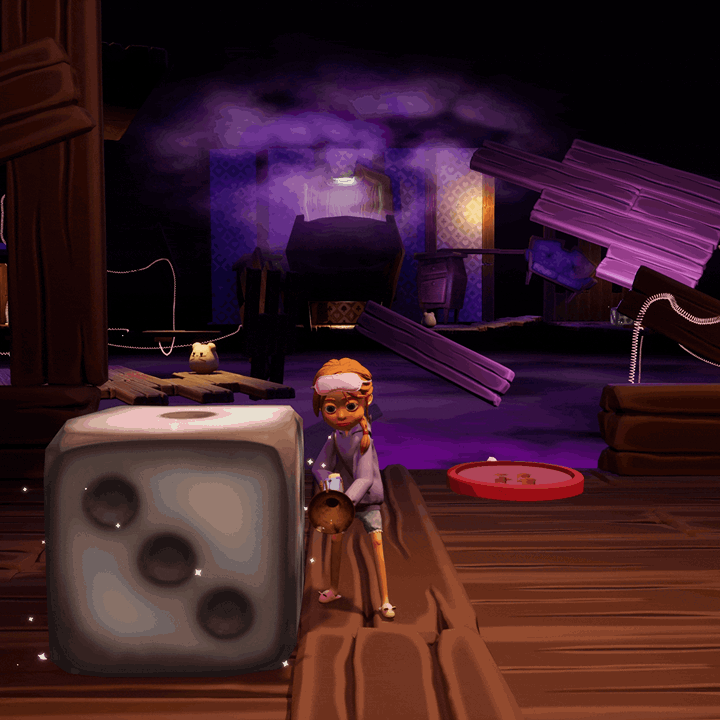
Rouse
About
Rouse is a 3rd person physics-based puzzle game. You play as Rose and as you wake up you find yourself in a dream of your little brother.
Use your magical blunderbuss to solve puzzles and save your brother from his nightmare!
The blunderbuss plays an essential role in solving the puzzles.
Along with the platform-friendly levels, the player is encouraged to combine the freedom of movement with the features of the blunderbuss to traverse through the environment.
In the early stages of the development our aim was to have the levels as a playground for physics.
We wanted to provide the tools and let the player feel smart coming up with solutions to problems.
In the end we had to cut back on the freedom to make level design more coherent,
though we still managed to leave enough room for the player to outsmart our design!
Responsibilities
My work mainly revolved around gameplay and more specifically the player movement, i.e. walking, jumping, sprinting and parts of the aiming, e.g. aiming down sights and how that effects the movement.
We knew that the platforming aspect would be essential in the level design, and therefore the maneuverability of the player had to be on par with that essentiality.
Apart from this I also acted as Scrum Master. I mainly got that responsibility because I have some professional experience of it, but this was not a predominant occupation during the project.
Jumping
The jumping went trough multiple iterations until it was finalized and was continuously tested and tuned.
It was important to have exactness as well as flow, all depending on what obstacles the player was faced with.
The jumping was divided into standing still (idle), moving (walking/jogging) and sprinting but all states utilized the same functionalities for jumping and falling - only parameters were set differently.
In all states (even when not jumping) the falling would be altered to increase over time by checking if if the player had a velocity in negative z.
If that was true, I used AddActorWorldOffset() to increase the change of z over time by a constant factor.



The primary reason for this alteration was to make jumping feel more snappy, which was especially useful for accuracy in smaller platforming scenarios.
This leads into another essential part in the snappiness of the jumping, especially when the player is moving or sprinting.
Initially I only added an upwards force (positive z) to make the player jump.
However, this make the jumping feel very buoyant.
The alteration of the falling helps, but by giving the player an extra push on the x-y plane when moving plus jumping, the snappiness was further increased.
This was done by using LaunchCharacter(), with a constant velocity of z, but altering x and y velocity.
The push in x and y was calculated by multiplying the current velocity in the respective direction with a constant factor.
So the push would be greater when the player is sprinting.
At all times, the player was also able to maneuver the player in the air, no matter the initial state before jumping.
Aiming down sights
Typically in third person games, aiming down sights (ADS) would move the camera closer to the player and/or change the field of view (FOV) for the camera. The ADS in Rouse was pretty important to get right, because that is the only way the player is able to shoot and engage in puzzles.


When the player is aiming a timeline is used to alter the length and offset of the spring arm between camera and player, as well as changing the FOV.
When the player stops aiming the timeline is reversed.
The position of the camera when aiming was conveniently positioned to disguise the lack of animation for the lower body when turning.
The aiming also slows down the movement and the mouse sensitivity.
If the player is sprinting it will be aborted, but directly continued if the player never releases the sprint-button.
This felt necessary to have, to avoid messing up the sense of flow we were going for in the movement.
Sprinting
The sprinting arrived late to the party and is not crucial to tackle the platforming.
However, the sprinting feature did a lot to the feel of the game, especially an increased sense of control.
Even if you were able to scale platforms and jump gaps without sprinting,
the received speed-up makes the player more comfortable doing it.

Thougths
In addition to everything already mentioned, I helped out with setting up animation and sound for the player,
doing a lot of playtesting (we only had QA part time) and by that refining my work.
This was the first time I and the rest of team worked with Unreal in a larger project, and it was an incredible learning experience.
Even though we worked in a project with such a large team, we managed to make everyone feel involved.
No ideas were rejected right off the bat, instead we often tried to reshape ideas to fit the game and the scope.
Every team member contributed with a wow moment - we were continuously impressed by the skills among ourselves.
The willingness to make something great together never faltered and in the end we managed
to make a game that we thought was fun to play.